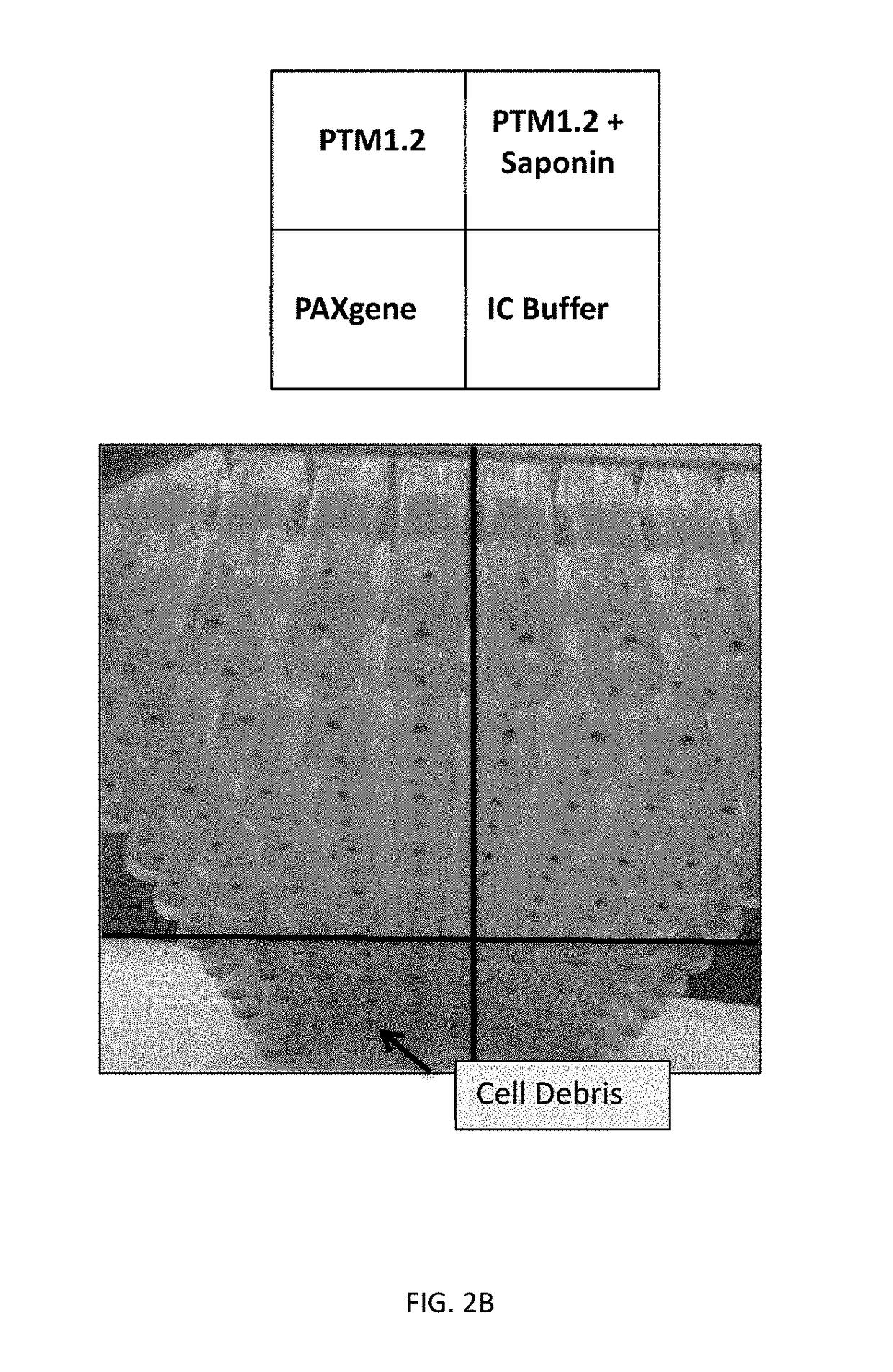Red blood cell lysis solution
a technology of red blood cells and lysis solution, which is applied in the direction of microorganism lysis, biochemistry apparatus and processes, instruments, etc., can solve the problems of difficult to isolate rna, reagents used in lysis may interfere with subsequent processing, and more difficult to detect rna or other target molecules
- Summary
- Abstract
- Description
- Claims
- Application Information
AI Technical Summary
Benefits of technology
Problems solved by technology
Method used
Image
Examples
example 1
Analysis of Reagents for Cell Lysis and Stabilization of Babesia RNA
[0099]The purpose of this example was to identify a lysis reagent that would effectively lyse red blood cells in human whole blood, stabilize Babesia-derived rRNA in the lysed sample, and inhibit the activity of RNAses. To be compatible with Gen-Probe's Target Capture Technology using magnetic beads, the lysis reagent should preferably result in a homogeneous lysate for efficient target capture.
[0100]The PAXGENE™ Blood RNA System (BD Biosciences) was first evaluated for Babesia sample preparation. The PAXGENE reagent contained in each tube comprises the active compound tetradecyltrimethylammonium oxalate (TDTMAO), a quaternary ammonium salt known to lyse cell membranes and act as a stabilizing reagent.
[0101]The sample used for preparation was human whole blood spiked with Babesia-infected hamster blood at a dilution ranging from 1×10−1 to 1×10−6. The blood sample (1 mL) was added to 3 mL of lysis reagent from a PAXG...
example 2
Evaluation of LLS in ACL Lysis Solution
[0108]The necessity of LLS in the buffered ACL solution was examined in this example. LLS was included in the buffered ACL solution at concentrations of 0% (control), 1%, 2%, 3%, and 5%. Human whole blood was spiked with Babesia-infected hamster blood at dilutions ranging from 1×10−7 to 1×10−9. Spiked whole blood samples were lysed with each of the buffered ACL / LLS solutions. Babesia 18S rRNA was detected in each sample using Procleix TCR and amplification by TMA as described above. As shown in FIG. 5, a decrease in the concentration of LLS results in greater variability of detection of the Babesia 18S rRNA. This is likely due to an insufficient amount of LLS present to stabilize the Babesia 18S rRNA target prior to amplification by TMA.
example 3
Sensitivity of Detection of Babesia
[0109]The sensitivity of detecting Babesia in human whole blood using buffered ACL and 5% LLS was examined. Human whole blood was spiked with Babesia-infected hamster blood at dilutions of 1×10−4 to 1×10−11. Blood samples were lysed with a lysis reagent of buffered ACL and 5% LLS. Babesia 18S rRNA was detected in each sample using Procleix TCR and amplification by TMA as described above. As shown in FIG. 6A, Babesia 18S rRNA could be detected in human whole blood at dilutions as low as 1×10−8 to 1×10−9 when using this lysis reagent and assay protocol.
[0110]The number of in vitro transcripts (IVTs) detectable by the method was also determined. The in vitro transcripts used in this experiment had the following sequence:
[0111]
(SEQ ID NO: 5)GGGCGAAUUGGGUACCGGGCCCCCCCUCGAGGUCGACGCUUAGUAUAAGCUUUUAUACAGCGAAACUGCGAAUGGCUCAUUAAAACAGUUAUAGUUUAUUUGAUGUUCGUUUUACAUGGAUAACCGUGGUAAUUCUAGGGCUAAUACAUGCUCGAGGCGCGUUUUCGCGUGGCGUUUAUUAGACUUUAACCAACCCUUCGGGUAAUCGGUGAUU...
PUM
| Property | Measurement | Unit |
|---|---|---|
| w/w | aaaaa | aaaaa |
| w/w | aaaaa | aaaaa |
| temperature | aaaaa | aaaaa |
Abstract
Description
Claims
Application Information
 Login to View More
Login to View More - R&D
- Intellectual Property
- Life Sciences
- Materials
- Tech Scout
- Unparalleled Data Quality
- Higher Quality Content
- 60% Fewer Hallucinations
Browse by: Latest US Patents, China's latest patents, Technical Efficacy Thesaurus, Application Domain, Technology Topic, Popular Technical Reports.
© 2025 PatSnap. All rights reserved.Legal|Privacy policy|Modern Slavery Act Transparency Statement|Sitemap|About US| Contact US: help@patsnap.com



